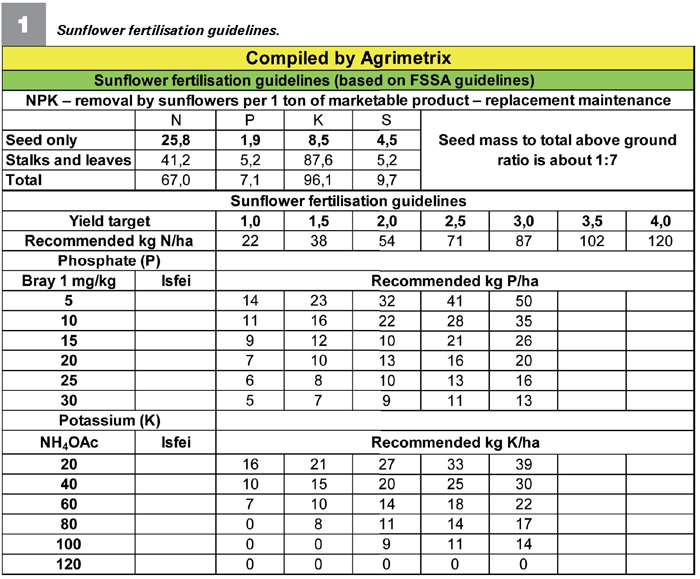October 2020
| Written by a retired farmer |  |
The planning for the fertilisation of any crop including sunflowers, which is the focus of this article, really should start with an examination of your soil status, current nutrient levels, the past fertilisation regime administered, your crop rotation plan and the yield results over a few seasons.
If you have not done a soil test in the last few years now is the time to do it. Please take the time and trouble to take the soil samples carefully as described in other articles. It is advisable to use the same laboratory over several seasons to ensure some consistency in the results so that the recommendations can be ‘calibrated’ for the yield results realised.
Calibration is a term used to measure how effective the fertiliser applied related to the recommendations. It can also be related to the actual yields obtained in practice. Establish a benchmark for your own yields in the same or differing soil types, on your farm, for sunflower yields for example and then make adjustments to the fertiliser regime if you need to increase your average yields.
SOILS
It must be remembered that when you use artificial fertilisers that you are feeding a very complex mixture of soil bacteria, fungi, and other organisms found in a healthy soil first. These then transform all these nutrients into plant available nutrients which can be taken up by the roots to enable plant growth through germination, vegetative growth, flowering and finally seed production.
Study your soil profiles, effective root depths and condition continuously as you farm. Those who have moved to a minimum till system and crop rotation will notice the improvement in soil structure, tilth and fertility. If you can build up humus in the soil your soil will be able to hold more plant nutrients which can become available to your sunflowers in the seed head and flowering stages. Please research the concept of humus if this is a new term or concept.
CROP ROTATION EFFECTS
In a rotation, for example, of maize-soybeans-sunflowers, the soybeans (inoculated with rhizobium bacteria), having formed effective nodules on the roots, would have fixed nitrogen from the air which in turn the soybean crop used to grow. The breakdown of the nodules after the harvesting of the soybeans would result in a build-up of organically available nitrogen for the following crop.
The estimates for the amount of nitrogen available for the next crop range from 10 kg to 40 kg per hectare depending on soil type, climate, previous crop yield, and tillage methods. This has been extensively researched in a continuous soybean to maize rotation. A minimum tillage system would tie up some nutrients in the plant residues left on the surface. In your considerations to fertilise your sunflowers you can allow for some tie up of nutrients in the crop residues as well as the nitrogen available in the soil.
A reasonable estimate might be about 25 kg of nitrogen (N) that could be available for the sunflowers planted after soybeans. An assessment of the status of your soil and reference to your soil test will enable you to decide which is the best option for your circumstances.
SUNFLOWER FERTILISATION RECOMMENDATIONS
It is generally accepted that sunflowers respond more to the build-up of soil fertility than the fertiliser applied at planting. Table 1 can be used as a guideline for your current crop requirements.

The new varieties with the correct cultivation methods are showing yields of 2 tons or more per hectare. It seems reasonable to target 2 t/ha to 2,5 t/ha yields in your planning.
If you target to fertilise for 2 t/ha after soybeans it would allow for the assumed 25 kg/ha of nitrogen reserve to produce up to 2,5 tons in a good season.
Refer to your soil test results. Assuming a phosphate (P) count of 25 parts per million (ppm) and a potassium (K) count of 80 ppm and a yield target of 2 t/ha the following nutrient supply would be required.
Kg N/ha required would be 52 kg; kg P/ha required would be 10 kg and kg K/ha required would be 11 kg (kg = kilograms).
It is assumed that all the fertiliser will be all placed at least 50 mm away from the seed at planting. Some farmers might do an additional leaf spray during the growth phase after a leaf test has been analysed for any nutrient shortage.
It is also an advantage to use a zinc containing fertiliser as well as one with a sulphur component sourced from ammonium sulphate. Ammonium sulphate is very kind to the soil microbes and can really enhance potential yields. If your soils are very high in potassium at above 120 ppm you can get away with no potassium in the applied fertiliser. Some soils might show a high test but is it available to the plant?
The example below assumes that you will plant with potassium using a 4.1.1 (27) rated fertiliser with 0,2% Zn + 16%K+9,0%S.
100 kg of the above mix will contain 18 kg of N, 4,5 kg of P and 4,5 kg of K.
Using the requirements shown above we need 52/18 = 2,88 x 100 kg of N, 10/4,5 = 2,22 x 100 kg of P, 11/4,5 = 2,44 x 100 kg of K/ha for a 2 t/ha yield.
An application of 300 kg of the 4.1.1 will supply 54 kg of N, 13,5 kg of P and 13,5 kg of K/ha which will build our P content and have enough nitrogen to reach our target of 2 tons and allow for a little nitrogen leaching in a very wet year.
The cost/ha for the above recommendation would be calculated from the delivered cost of about R6,100/ton as R6,100/1 000 kg/ton = R6,10/kg x 300 kg/ha for a total cost per ha of R1,830 per hectare. (A 4,1,0 mixture would be about R410 lower if your K status is far above 120 ppm).
Many granular or liquid mixes are available from different fertiliser suppliers but the actual mix applied might be a compromise between all the nutrient requirements planned for the application and the cost thereof.
CONCLUSION
Assess your soil conditions, do proper soil tests and provide enough fertiliser to achieve your target yield to ensure that a profitable sunflower crop is harvested.

Publication: October 2020
Section: Pula/Imvula